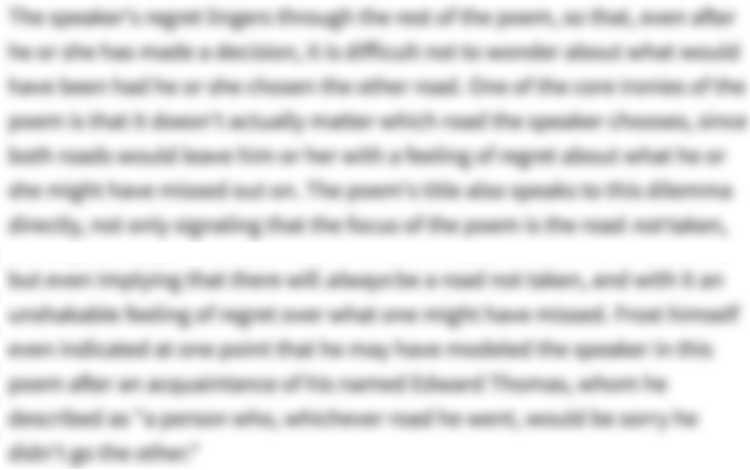-
“The Shield of Achilles” Introduction
-
-
“The Shield of Achilles” Summary
-
-
“The Shield of Achilles” Themes
-

The Horrors of War
Where this theme appears in the poem:- Lines 7-8
- Lines 9-22
- Lines 31-37
- Lines 38-44
- Line 52
- Lines 60-67
-

Modern Apathy Towards Violence
Where this theme appears in the poem:- Lines 7-8
- Lines 12-22
- Lines 23-37
- Lines 38-44
- Lines 45-59
- Lines 62-67
-

The Limitations of Art
Where this theme appears in the poem:- Lines 1-67
-
-
Line-by-Line Explanation & Analysis of “The Shield of Achilles”
-
Lines 1-8
She looked over ...
... sky like lead. -
Lines 9-15
A plain without ...
... for a sign. -
Lines 16-22
Out of the ...
... else, to grief. -
Lines 23-30
She looked over ...
... Quite another scene. -
Lines 31-37
Barbed wire enclosed ...
... in the ground. -
Lines 38-44
The mass and ...
... their bodies died. -
Lines 45-52
She looked over ...
... a weed-choked field. -
Lines 53-59
A ragged urchin, ...
... because another wept. -
Lines 60-67
The thin-lipped armorer, ...
... not live long.
-
-
“The Shield of Achilles” Symbols
-

The Original Shield
Where this symbol appears in the poem:- Lines 2-4: “vines and olive trees, / Marble well-governed cities / And ships upon untamed seas”
- Lines 24-26: “ritual pieties, / White flower-garlanded heifers, / Libation and sacrifice”
- Line 28: “the altar”
- Lines 46-49: “athletes at their games, / Men and women in a dance / Moving their sweet limbs / Quick, quick, to music”
- Line 51: “dancing-floor”
-

The Modern Shield
Where this symbol appears in the poem:- Lines 7-8
- Lines 9-22
- Lines 31-44
- Lines 52-59
- Line 64
-
-
“The Shield of Achilles” Poetic Devices & Figurative Language
-
Allusion
Where allusion appears in the poem:- Lines 1-8
- Line 14
- Lines 23-30
- Lines 31-37
- Lines 38-49
- Lines 60-67
-
Anachronism
Where anachronism appears in the poem:- Line 14: “A million eyes, a million boots in line”
- Line 17: “statistics”
- Lines 31-33: “Barbed wire enclosed an arbitrary spot / Where bored officials lounged (one cracked a joke) / And sentries sweated”
-
Assonance
Where assonance appears in the poem:- Line 1: “over,” “shoulder”
- Line 4: “upon,” “untamed”
- Line 8: “sky like”
- Line 9: “plain”
- Line 10: “blade,” “neighborhood”
- Line 12: “congregated,” “blankness”
- Line 13: “unintelligible,” “multitude”
- Line 19: “discussed”
- Line 20: “Column,” “column,” “dust”
- Line 23: “over,” “shoulder”
- Line 24: “pieties”
- Line 25: “White”
- Line 26: “Libation,” “sacrifice”
- Line 27: “shining”
- Line 29: “light”
- Line 30: “Quite”
- Line 39: “weight,” “always weighs,” “same”
- Line 40: “Lay”
- Line 43: “pride”
- Line 44: “died,” “died”
- Line 45: “over,” “shoulder”
- Line 48: “limbs”
- Line 49: “Quick,” “quick,” “music”
- Line 53: “aimless”
- Line 54: “vacancy”
- Line 55: “safety,” “aimed”
- Line 56: “raped”
- Line 64: “god,” “wrought”
- Line 65: “strong”
- Line 67: “not,” “long”
-
Consonance
Where consonance appears in the poem:- Line 1: “She,” “over,” “shoulder”
- Line 2: “vines,” “olive”
- Line 3: “Marble well-governed cities”
- Line 4: “ships,” “seas”
- Line 5: “shining”
- Line 6: “His hands had,” “instead”
- Line 7: “artificial,” “wilderness”
- Line 8: “sky like lead”
- Line 9: “bare,” “brown”
- Line 10: “No,” “blade,” “no sign,” “neighborhood”
- Line 11: “Nothing,” “nowhere,” “down”
- Line 12: “congregated,” “blankness”
- Line 13: “unintelligible multitude”
- Line 14: “million,” “million,” “line”
- Line 15: “Without,” “waiting”
- Line 16: “voice,” “face”
- Line 17: “statistics,” “some cause,” “just”
- Line 18: “place”
- Line 19: “No one,” “and nothing,” “discussed”
- Line 20: “Column,” “column,” “cloud,” “dust”
- Line 23: “She,” “shoulder”
- Line 24: “ritual”
- Line 25: “flower-garlanded,” “heifers”
- Line 26: “Libation,” “sacrifice”
- Line 27: “shining”
- Line 28: “should”
- Line 29: “She,” “flickering,” “forge”
- Line 31: “Barbed wire,” “enclosed,” “arbitrary”
- Line 32: “Where bored,” “cracked,” “joke”
- Line 33: “sentries sweated”
- Line 34: “crowd,” “ordinary decent folk”
- Line 35: “Watched,” “without,” “spoke”
- Line 36: “pale”
- Line 37: “posts,” “upright”
- Line 38: “mass,” “majesty,” “world”
- Line 39: “weight,” “always weighs”
- Line 40: “others,” “they”
- Line 41: “hope,” “help,” “help”
- Line 42: “do,” “done”
- Line 43: “Was,” “worst,” “wish,” “pride”
- Line 44: “And,” “died,” “before,” “bodies,” “died”
- Line 45: “She,” “shoulder”
- Line 47: “Men,” “women”
- Line 48: “Moving,” “limbs”
- Line 49: “Quick,” “quick,” “music”
- Line 50: “shining shield”
- Line 51: “ His hands had”
- Line 53: “aimless,” “alone”
- Line 54: “Loitered”
- Line 55: “Flew,” “safety”
- Line 58: “world where,” “were”
- Line 59: “weep,” “wept”
- Line 61: “Hephaestos,” “hobbled”
- Line 67: “live long”
-
End-Stopped Line
Where end-stopped line appears in the poem:- Line 2: “trees,”
- Line 4: “seas,”
- Line 8: “lead.”
- Line 9: “brown,”
- Line 10: “neighborhood,”
- Line 11: “down,”
- Line 13: “multitude,”
- Line 14: “line,”
- Line 15: “sign.”
- Line 18: “place:”
- Line 19: “discussed;”
- Line 22: “grief.”
- Line 24: “pieties,”
- Line 25: “heifers,”
- Line 26: “sacrifice,”
- Line 28: “been,”
- Line 30: “scene.”
- Line 32: “joke)”
- Line 33: “hot:”
- Line 37: “ground.”
- Line 41: “came:”
- Line 44: “died.”
- Line 46: “games,”
- Line 49: “music,”
- Line 52: “field.”
- Line 53: “alone,”
- Line 55: “stone:”
- Line 56: “third,”
- Line 58: “kept,”
- Line 59: “wept.”
- Line 60: “armorer,”
- Line 61: “away,”
- Line 67: “long.”
-
Enjambment
Where enjambment appears in the poem:- Lines 1-2: “shoulder / For”
- Lines 3-4: “cities / And”
- Lines 5-6: “metal / His”
- Lines 7-8: “wilderness / And”
- Lines 12-13: “stood / An”
- Lines 16-17: “face / Proved”
- Lines 17-18: “just / In”
- Lines 20-21: “dust / They”
- Lines 21-22: “belief / Whose”
- Lines 23-24: “shoulder / For”
- Lines 27-28: “metal / Where”
- Lines 29-30: “forge-light / Quite”
- Lines 31-32: “spot / Where”
- Lines 34-35: “folk / Watched”
- Lines 35-36: “spoke / As”
- Lines 36-37: “bound / To”
- Lines 38-39: “all / That”
- Lines 39-40: “same / Lay”
- Lines 40-41: “small / And”
- Lines 42-43: “shame / Was”
- Lines 43-44: “pride / And”
- Lines 45-46: “shoulder / For”
- Lines 47-48: “dance / Moving”
- Lines 48-49: “limbs / Quick”
- Lines 50-51: “shield / His”
- Lines 51-52: “dancing-floor / But”
- Lines 54-55: “bird / Flew”
- Lines 57-58: “heard / Of”
- Lines 62-63: “breasts / Cried”
- Lines 63-64: “dismay / At”
- Lines 64-65: “wrought / To”
- Lines 65-66: “strong / Iron-hearted”
- Lines 66-67: “Achilles / Who”
-
Juxtaposition
Where juxtaposition appears in the poem:- Lines 1-22
- Lines 23-37
- Lines 38-44
- Lines 45-59
-
Metaphor
Where metaphor appears in the poem:- Lines 38-40: “The mass and majesty of this world, all / That carries weight and always weighs the same / Lay in the hands of others; they were small”
- Line 44: “died as men before their bodies died”
- Line 66: “Iron-hearted”
-
Repetition
Where repetition appears in the poem:- Lines 1-2: “She looked over his shoulder / For”
- Line 5: “ But there on the shining metal”
- Line 6: “His hands had”
- Line 10: “No,” “no”
- Line 11: “Nothing,” “nowhere”
- Line 14: “A million eyes, a million boots”
- Line 20: “Column,” “column”
- Lines 23-24: “She looked over his shoulder / For”
- Line 27: “But there on the shining metal”
- Line 39: “weight,” “weighs”
- Line 41: “help,” “help”
- Line 42: “do,” “done”
- Line 44: “died,” “died”
- Line 49: “Quick, quick,”
- Line 59: “weep,” “wept”
- Line 62: “ Thetis of the shining breasts”
-
Alliteration
Where alliteration appears in the poem:- Line 1: “She,” “shoulder”
- Line 4: “ships”
- Line 5: “shining”
- Line 6: “His hands had”
- Line 8: “like lead”
- Line 9: “bare,” “brown”
- Line 10: “No,” “blade,” “no,” “neighborhood”
- Line 11: “Nothing,” “nowhere”
- Line 13: “multitude”
- Line 14: “million,” “million”
- Line 15: “Without,” “waiting”
- Line 20: “Column,” “column,” “cloud”
- Line 23: “She,” “shoulder”
- Line 27: “shining”
- Line 28: “should”
- Line 29: “She,” “flickering forge”
- Line 31: “Barbed”
- Line 32: “bored”
- Line 33: “sentries sweated”
- Line 35: “Watched,” “without”
- Line 36: “pale”
- Line 37: “posts”
- Line 38: “mass,” “majesty,” “world”
- Line 39: “weight,” “weighs”
- Line 41: “hope,” “help,” “help”
- Line 42: “do,” “done”
- Line 43: “Was,” “worst,” “wish”
- Line 44: “before,” “bodies”
- Line 45: “She,” “shoulder”
- Line 50: “shining shield”
- Line 51: “His hands had”
- Line 58: “world where,” “were”
- Line 59: “weep,” “wept”
- Line 61: “Hephaestos,” “hobbled”
- Line 65: “son,” “strong”
- Line 67: “live long”
-
Simile
Where simile appears in the poem:- Line 8: “And a sky like lead.”
- Line 18: “In tones as dry and level as the place:”
-
-
“The Shield of Achilles” Vocabulary
Select any word below to get its definition in the context of the poem. The words are listed in the order in which they appear in the poem.
- She looked over his shoulder
- Unintelligible
- Multitude
- Enduring
- Pieties
- Libation
- Forge-light
- Abitrary
- Sentries
- Urchin
- Loitered
- Axioms
- Thin-lipped
- Armorer
- Hephaestos
- Thetis
- Wrought
- Iron-hearted
- Achilles
She looked over his shoulder-
(Location in poem: Line 1: “She looked over his shoulder”; Line 23: “She looked over his shoulder”; Line 45: “She looked over his shoulder”)
-
Form, Meter, & Rhyme Scheme of “The Shield of Achilles”
-
Form
-
Meter
-
Rhyme Scheme
-
-
“The Shield of Achilles” Speaker
-
-
“The Shield of Achilles” Setting
-
-
Literary and Historical Context of “The Shield of Achilles”
-
-
More “The Shield of Achilles” Resources
-
External Resources
-
Auden Reads “The Shield of Achilles” — Listen to a recording of the author reading the poem aloud.
-
Auden's Life Story — A detailed look at the author’s life and works from the Poetry Foundation.
-
"The Shield of Achilles," First Edition — Scans of Auden’s 1955 poetry collection, including the title poem in its original format.
-
Visualizing Achilles’s Shield — Browse various artistic interpretations of Achilles’s shield.
-
The Iliad Study Guide — A guide to Homer’s Iliad from LitCharts, including a concise summary and a discussion of the shield of Achilles as a symbol.
-
-
LitCharts on Other Poems by W. H. Auden
-










